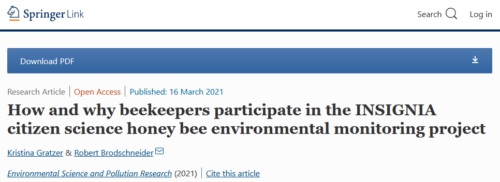Citizen science is becoming more and more popular these days, although no universal definition of the term exists. The most important aspects include the recruitment and training (or instruction) of volunteers – so-called citizen scientists. Even though citizen science has a long tradition in entomology and especially in the research on honey bees and bumblebees, the term has only been used for a relatively short time.
Researchers from the University of Graz for the first time ever investigated what motivates beekeepers to voluntary participate in a citizen science study like INSIGNIA. This specific group of citizen scientists was also asked what expectations they had from participating, which study aspects were easy or difficult for them and whether they saw added value from their participation.
The project can roughly be divided into two large parts. The first one served as a pilot study and was conducted from May to September 2019. A total of 16 beekeepers from four European countries (Austria, Denmark, UK and Greece), each with three bee colonies, took part. The aim was to identify the best suitable of four possible non-invasive sampling techniques. Part two of the project took place from May to September in 2020 and was based on the experiences of the previous year. A total of 82 volunteers from 10 European countries (the four mentioned, plus Belgium, Norway, Italy, Latvia, France, Ireland) took part and examined the environment – each one with two of their colonies.
The beekeepers’ tasks included taking samples from two bee colonies every two weeks, as well as regular online documentation of the samplings, reporting the flowering plants in vicinity of the test apiaries, storage and transport of the samples, as well as answering a voluntary survey at the end of the 2020 season.
What have we learned about the citizen scientists?
Most volunteering beekeepers are experienced. The average age of participants was 55 years and the citizen scientists had on average 20 years of experience in the field of beekeeping. This was also reflected in the number of colonies they take care of. Although the absolute numbers vary between 3 and 320, on average 70 colonies were managed at the time of the survey.
The most important reasons given for participating in the INSIGNIA study were to support science and the environment, followed by the desire to learn more about honey bees. Almost all participants (97%) reported that receiving laboratory analysis results of the samples to be the most important form of appreciation. A beekeeper spent on average 10.4 working hours for all participation tasks throughout a season. Despite the effort, the subjective assessment of the study’s difficulty level was rather low (2.5 on a scale from 1 to 10). Furthermore, our survey resulted in a high recommendation rate, as well as the desire to participate in similar citizen science studies.
This study demonstrates the great potential, beekeepers have to support research in a variety of ways. The knowledge gained can be used to better understand the target group and, based on this, to improve future study designs and the recruitment process, as well as to keep citizen scientists’ motivation high during the study. Further steps for citizen science in bee research should be to actively involve citizens in defining research questions and to collaboratively develop experimental design.
The INSIGNIA project ends in April, but work is underway to publish the results of the pollen and pesticide analyzes as soon as possible. The latest project events can be followed in the blog on the INSIGNIA website.
We would like to take this opportunity to thank the participants of the INSIGNIA study for their commitment. Through you, we were able to gain important insights that will serve future research.

